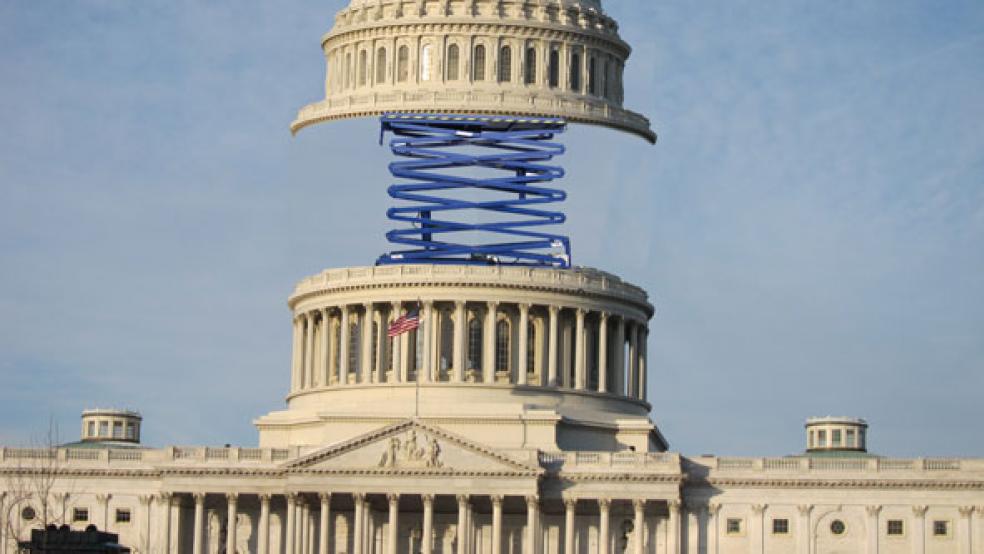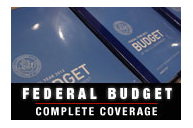The current budget showdown is just a teaser for a vicious battle over the debt ceiling—which could easily tank the entire economy.
Right now, President Obama and congressional Republicans are dueling over how to keep the government open when the next fiscal year starts Oct. 1. House Republicans insist on defunding Obamacare, a demand that the Democratic majority Senate is poised to reject this week. Without a deal in place by Oct. 1, the big threat is a government shutdown.
RELATED: MISSING: A GOP EXIT STRATEGY ON BUDGET BATTLE
That’s a problem – though Federal Reserve Chairman Ben Bernanke and many economists think it’s small potatoes compared to what happens in the middle of October.
At that point, the Treasury Department exhausts the extraordinary measures in place since May to stave off the debt ceiling. The U.S. government, already $16.7 trillion in debt, starts to default on many obligations.
To put that in perspective, the mere threat of a default back in 2011 was enough to cause the stock market to plunge, hiring to stall, and economists to warn about a recession on the horizon. All of this could be repeated – but the Fed might not have the ability to cushion the blow.
“The Federal Reserve's policy is to do whatever we can to keep the economy on course,” Bernanke said last week in a news conference. “That being said, you know, again, our ability to offset these shocks is very limited.”
The fallout would be so devastating that many economists think its specter should be enough to force Obama and Congress to reach an agreement on the debt ceiling.
“This would be disastrous,” Stuart Hoffman, chief economist at PNC Bank, said in a Monday note. “Because the consequences of not raising the debt ceiling would be so severe, Republicans and Democrats are likely to work out a deal to increase it before the Treasury Department becomes unable to borrow.”
But just how a deal comes together remains a mystery for the moment.
WHAT THE GOP WANTS
House Majority Leader Eric Cantor (R-VA) recently previewed what the GOP wants in return for raising the debt limit. The wish list includes a delay to implementing Obamacare, tax reform, means-testing on Medicare, and approval to build the Keystone XL oil pipeline. The House could vote on the proposal—which would raise the debt ceiling through the end of 2014—as early as Friday.
Obama refuses to even approach the bargaining table, a position that could become untenable as the deadline approaches.
“What I will not do is to create a habit, a pattern, whereby the full faith and credit of the United States ends up being a bargaining chip to set policy,” he said last week in a speech to the Business Roundtable. “It’s irresponsible. The last time we did this in 2011, we had negative growth at a time when the recovery was just trying to take off.”
That previous face-off shows that an extremely rocky road lies ahead. The White House and Capitol Hill eventually reached a last-minute deal in the summer of 2011 that involved more than $2.1 trillion in spending cuts over 10 years, including the sequester that forced automatic reductions to the budgets of the Pentagon and discretionary social programs.
When that drama played out, the stock market plunged, and with it, some investors’ retirement savings. The S&P 500 index dropped by 14.63 percent from July 22 to Aug. 19, 2011. It took six months for stock prices to recover from the dip after a last-minute deal.
Since the House passed its temporary spending measure to defund Obamacare last Friday, the S&P has already fallen by 1.58 percent, closing on Monday at 1,701.84.
INVESTORS: BE PREPARED
Oppenheimer Funds’ chief economist Jerry Webman expects some kind of deal to be reached, but “investors should be prepared for volatility in the coming weeks, as the brinksmanship in these situations has a recent history of lasting until the eleventh hour and fifty-ninth minute.”
RELATED: WALL STREET WATCH: FROM FED SURPRISE TO FISCAL SHOCK
The Treasury market could be even crazier. When a country defaults on obligations, the interest rate paid on its debt should increase—making it harder for everyone to borrow. Standard & Poor’s downgraded the government’s credit rating in response to the near catastrophe in 2011. In that year, the debt ceiling crisis caused enough of a panic that Treasury notes became a safe haven, with interest rates on the 10-year dropping below 2 percent as investors piled in. The 10-year yield is currently 2.7 percent.
Bizarrely, market gyrations did little in 2011 to influence the debt ceiling talks. Politicians seemed unresponsive to the signals coming from investors, doing little to change their rhetoric as the country came perilously close to an unprecedented default.
With the debt ceiling in 2013, there are overlapping risks that could amplify the damage this time around. Unlike two years ago, the negotiations could occur after a government shutdown, the economic equivalent of being hit by two earthquakes.
Analysts at Bank of America put the odds of a government shutdown at 30 percent, up from 15 percent just a week ago. Brian Gardner, the Washington analyst for the investment bank Keefe, Bruyette & Woods, has the chances at 40 percent.
And even if Obama and Congress reach a deal on spending, it would only last until Dec. 15. So the debt ceiling is sandwiched between two major budget quarrels.
“This crisis is sure to last until Christmas and thus could become a headwind for the economy—maybe not a howling headwind, but in a recovery that’s still fragile, this nonsense doesn’t help,” said Greg Valliere, chief political strategist at the Potomac Research Group.
CAPITAL HILL CHAOS
The potential crisis suddenly has the Fed trying to game Capitol Hill when setting policy, a choice that could weaken the central bank’s credibility as it attempts to steer through the recovery.
Last week, Fed officials decided to continue stimulating the economy with bond purchases totaling $85 billion a month. The market had anticipated that the Fed would reduce the size of its purchases, as suggested by past guidance.
New York regional Fed president William Dudley said in a Monday speech that “fiscal uncertainties” with Congress influenced their decision. But Dallas regional Fed president Richard Fisher countered in a separate speech that deferring to those concerns hurt the authority of the central bank’s guidance. “You should never wink at a girl in the dark,” he said. “Our communications policy is a little off – we should work harder to refine it.”
All of this creates a troubling hazard for navigating through the debt ceiling maze. If the White House and Capitol Hill are gridlocked, then the ability of the Fed to respond may also be compromised, leaving the economy vulnerable.
“When agendas of U.S. politicians do not converge in the national interest and do not have the full or broad support of the country,” David Kotok, co-founder of Cumberland Advisors, wrote to investors, “problems arise when politics intervene in the conduct of central banking.”





